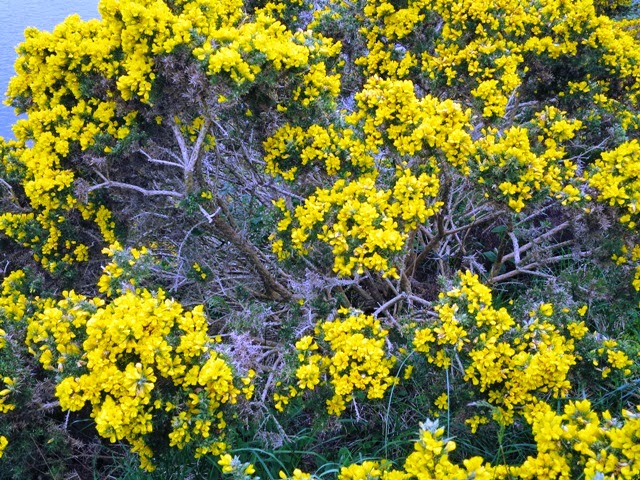We only
planned to stay a day (two evenings) on Skye as it was a special visit to
attend the funeral of my late Auntie Morag, RIP. My mother was one of ten
siblings and Auntie Morag, the widow of my late Uncle Harry, RIP, was the last
of that particular line of siblings and their spouses. She died at the grand
old age of 98.
Leaving
Inverness, we motored across the north-west Highlands, speeding along deserted twisting
roads, past bare dun-coloured moorland, occasional still lochs, remains of ancient
forests and newer plantations of fir and spruce. Higher still we climbed, Sgurr
Mór in the distance, over 1,000 meters high, patches of snow glistening ahead
of us. Then the road began to dip and we slowly descended the other side of the ridge. It was late Spring and the heather has not yet gained the rich purple colour that would carpet the Highlands in autumn.
However, the dull colours were a perfect foil for the brilliant yellow flowers of the gorse bushes, which grew in profuse clumps along the sides of the road.
(note to self: must clean the lens on my camera!)
All too soon
we reached Kyle of Lochalsh, the mainland opposite Skye where the Skye Bridge,
built just over 20 years ago, now affords easy access to the island. The view
from the top of the bridge is stunning with several islands sprinkled below,
sparkling grey-blue waters that stretch into the distance, the mist-wrapped bulk
of Skye before us – alas, the poor driver can only manage a brief glimpse
before he has to wrench his gaze back to the road.
In Skye, we drove past the Cuillin Hills, again topped with snow, as we drove to the main town, Portree, for dinner. It’s very pretty, particularly at the quiet, sleepy harbour with its pastel-coloured houses and the sturdy pier designed by the famous road and canal builder Thomas Telford a couple of hundred years ago.
The
little town has the only secondary school on the island - which I once attended
- and is the island’s cultural and business centre. The name Portree is
supposedly from the Gaelic, Port Righ,
the King’s Port, commemorating the visit to Skye in 1540 of King James V of
Scotland.
The place
was rather busy with early-season tourists, mainly Europeans but also Americans
and a substantial number of Asians. In fact, there were queues for tables at
several of the restaurants. Sadly, my curry-influenced mussel sauce drowned the
flavour of the shellfish while the salmon steak managed to be both overdone
and underdone in parts. Maybe the town’s culinary reputation is why King James
never came back after 1540...
The funeral
was held in a small church in the north of the island, a place of small crofts,
scattered white houses and wandering sheep. It
overlooked the blue Minch and in the distance the grey outline of the islands
of the Outer Hebrides. Despite a forecast of showers or constant heavy rain, the
sky was filled with wispy clouds and the sun occasionally broke through - although
the wind off the sea was bitterly cold.
In deference
to the lack of Gaelic-speakers among the visiting mourners, the sung praise was
in English; the words from the beautiful Scots Metrical Psalter of 1650, Psalms
23 and 121. The two Presenters led the singing, their voices strong, the tempo slow
– very slow – lending a majesty, authority and power to the words. As usual in
the Church of Scotland, we stood to sing and sat for the prayers, the eulogy
and the homily.
Then, the
long convoy of cars followed the hearse to the graveyard, a ten minute journey.
We stood in the gusting cold wind, the words of the minister snatched from his
mouth as we strained to hear. A final ‘Our
Father’ and Auntie Morag was buried beside her husband, near to other
MacKinnon siblings, and a couple of hundred yards away from where Flora MacDonald,
saviour of Bonnie Prince Charlie, was buried 225 years ago. There is in that
dust a richer dust concealed...
Afterwards
we repaired to the Uig Hotel for tea, sandwiches and cake, and I met cousins I
had never seen, or had last seen in infancy and could not recall - or had not
seen for more than 45 years in at least one case! No wonder we lingered over
the meal...then it was back to our hotel in Broadford.
Skye’s
reputation for food was also restored that evening, We ate in a little
restaurant opposite the Dunollie Hotel in Broadford. Skye is justly famous for
its seafood and we enjoyed a platter of scallops, mussels, crayfish, langoustines
and squid, accompanied by a glass of dry white Spanish wine and topped off by a
generous helping of cranachan, a traditional Scottish desert, an alternative to
trifle, made of toasted oatmeal, whipped cream, honey and raspberries.
I slept so
well that when the hotel’s alarum system went off at 6am – a guest had
mistakenly set it off by using a hairdryer too near the fire sensor – I didn’t mind
the early rise and greeted the other befuddled guests milling around in the
lobby, variously dressed in pjs under coats and other night attire...
A couple of hours later we rose for breakfast.
Our hotel's restaurant was almost at the water's edge, facing Broadford Bay, overlooking a small pier. The tide was out and we could see the small island of Pabay a couple of miles away, once notorious in the sixteenth century as a haunt of thieves and cut-throats, now more famous for its unique geology, its stamps and the ruins of a thirteenth chapel. Then, it was time to leave...







No comments:
Post a Comment